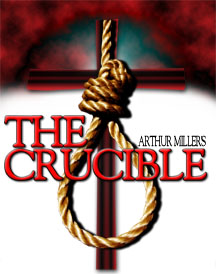Review: The Crucible by Renaissance Austin
by Michael Meigs
Arthur Miller's play The Crucible deals with dark and frightening times. Though the setting is 1692 Salem, Massachusetts during the wide-ranging hunt for witches, this 1953 piece is equally an evocation of America's sudden dark fear of enemies in its midst. Just years earlier, in World War II the Soviet Union had been considered a valiant ally; with the division of Europe, the threat of the atom bomb and the populist hectoring of politicians such as Senator Joseph McCarthy, many American intellectuals, civil servants and diplomats found themselves targeted for "communist sympathies."
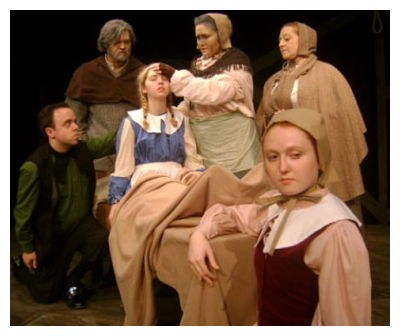
This was the context for The Crucible. It's a strong, at times poetic piece, but much of the play's power and lasting relevance comes from Miller's admonitory lesson about hysteria, prejudice and injustice. In an essay about the play written in 2000 when he was eighty-five, Arthur Miller commented,
The Crucible straddles two different worlds to make them one, but it is not history in the usual sense of the word, but a moral, political and psychological construct that floats on the fluid emotions of both eras. As a commercial entertainment the play failed [it opened in 1953]. To start with there was the title: nobody knew what a crucible was. Most of the critics, as sometimes does happen, never caught on to the play's ironical substructure, and the ones who did were nervous about validating a work that was so unkind to the same sanctified procedural principles as underlay the hunt for reds. . . . Several years after, a gang of young actors, setting up chairs in the ballroom of the McAlpin Hotel, fired up the audience, convinced the critics, and the play at last took off and soon found its place. There were cheering reviews but by then Senator McCarthy was dead. The public fever on whose heatwaves he had spread his wings had subsided.
The Crucible has been Miller's most produced play worldwide. He noted wryly that sometimes it appeared that he might be able to predict the imminent arrival or overthrow of a Latin American dictator by the number of times The Crucible was being produced in the country. His following comment might be considered an apt summary of the play's theme:
There are no passions quite as hot and pleasurable as those of the deluded. Compared to the bliss of delusion, its vivid colours, blazing lights, explosions, whistles and liberating joys, the search for evidence is a deadly bore.
The chief flaw in the production of The Crucible by Renaissance Theatre Company at the City Theatre is its neglect of that context. The program contains no more explication than Miller's short note from the script on the issue of historical accuracy, focused only on the writer's liberties taken in transforming the dense, cryptic historical records into a stage narrative.
One might argue that conditions have changed greatly since 1953, a contention that I would quickly accept. That truth does not obviate the need to deliver the amplified lesson. The early 1950's were a time of sharp edges, rigid politics, received truth and xenophobia, when a great majority of Americans could accept without blinking the activities and title of the House Committee on Un-American Activities. Despite their huge, unwanted engagement in a world war American citizens at that time were naïve and self-certain.
Today, in a country pulsing with technology and awash in more news, opinion, trivia and distraction, Americans are just as simplistic and far more impatient. Our cognitive world has exanded enormously, with a concommitant loss of sharp edges and focus, but we are no less susceptible to passions and condemnations.
Miller's title has resonance for our own times. A "crucible" is a receptacle used for mixing materials at extremely high temperatures, as in a laboratory or a smelting furnace. In simplest terms, a "melting pot," for a nation in which that metaphor is more and more in question.
I have a special relation with this play, for I was part of a university production of it during my freshman year at university. It was the one of first "serious" plays with which I was associated. I told Jeff Hinkel at the City Theatre I was trying to remember which character I had played in the late 1960's, a time gripped by its own hysteria. I must have been on the crew rather than in the cast, because the text rang with familiarity but none of those speeches had come from my mouth.
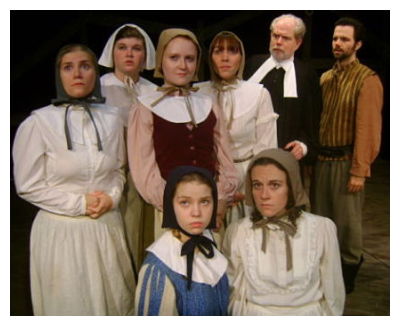
The Crucible is a strong, bitter draught. In brief, young women frolicking in the woods in naughty innocence are spotted and escape punishment by claiming that they were bewitched. That's a potent claim in a land that believes firmly in evil and in the existence of witches. Emotion and personal dislikes cloud investigations, the lustful young Abigail finds herself with unexpected powers of accusation, hot-headed local pastor Rev. Paris seeks to protect himself, and the well-read, earnest divine Rev. John Hale arrives to investigate.
Central figures are the hard-working farmer John Proctor and his wife Rebecca, estranged from one another. Proctor is guilt-ridden over a sexual encounter with Abigail, who deceitfully and purposefully works to have goodwife Rebecca condemned for sorcery.
Act II opens deep in the hysteria, with a dozen women already condemned to hang. Both Proctors are arrested and interrogated at length in accusatory terms by Deputy Governor Danforth. All accused and condemned find themselves in what Joseph Heller later labeled the "Catch 22" situation of logical paradox. They believe in religion, God, punishment and hell, but the only way they can escape burning is by confessing to the untruth that they have practiced witchcraft. Through Danforth, Miller grinds the Proctors exceeding small, using implacable, impossible logic to push them into a choice between eternal damnation and merely perishing by fire.
Craig Kanne as the excitable Rev. Parris is given to hand wringing and expostulation that do not seem in keeping with his office. Angela Loftus is the real witch of the piece, the sullen Abigail, with a consistent opaqueness and determination that are really scary. Michelle Alexander is the slave woman Tituba, gleeful at the opening but confused, degraded and eventually heart-breaking under interrogation -- one of the strongest moments comes in Act II when the broken Tituba looks out the window and laughs to see the devil arriving (Deputy Governor Danforth, come to investigate).
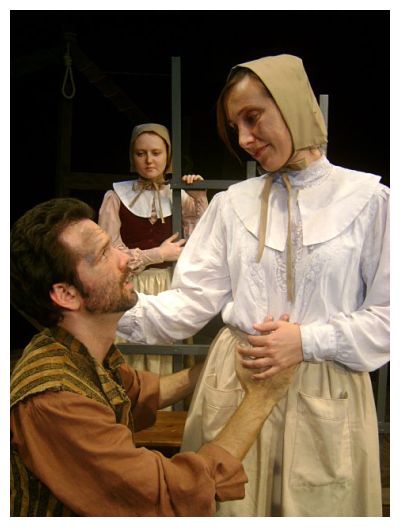
The Proctors have a deliberately unbalanced relationship, with Brian Villalobos as John obliged to push restrained emotions inch by inch to the breaking point and Rachel McGinnis as honest goodwife Elizabeth assigned to saintly restraint. Laura Ray as the Proctor's simple servant Mary Warren must switch from one camp to another and back again, at great emotional cost, in a role that must be terrifically draining.
Miller sets ecclesiastical authorities against one another in this piece. Rev. Parris never does "get it," remaining intent on saving his own position, while John McNeil as Deputy Governor Danforth in this theocracy is the cherubic face of evil. I would have preferred to see him more implacable, but perhaps I am still influenced by memories of the ferocious Cecil D. Jones, my theatre professor, in that role. McNeil's delivery is light, almost rambling, and at times he appeared to grasp for a phrase in his text.
abriel Smith as Rev. Hale, the first investigator, is the conscience of the play. No less devout than any, Hale is the stern face of rebuke and justice in the first act, but by the second he has become convinced of the falsity of the process. Hale works hard to save lives, despite his fear of God, lying and sin, and his failures are palpable, accumulating one by one. This role fits Gabriel Smith like a glove. Initially he has the pugnacious attitude of a small man often put upon, and in the second act's world of hysteria he is in control of his own emotions, although only by the narrowest of margins. The accused and condemned suffer injustice, but Hale must swallow defeat.
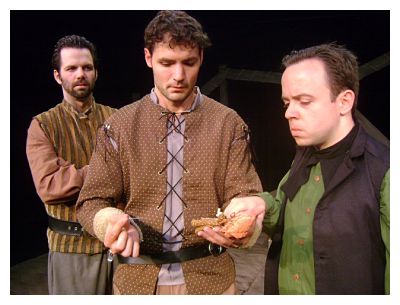 Director Stacy Glazer and her cast of twenty serve the script well. The Crucible is a harsh play, done against a dark background, and you may find it long and wearing in its intensity. It remains an important and gripping drama, fundamental to the canon of American theatre.
Director Stacy Glazer and her cast of twenty serve the script well. The Crucible is a harsh play, done against a dark background, and you may find it long and wearing in its intensity. It remains an important and gripping drama, fundamental to the canon of American theatre.
Review by Elizabeth Cobbe for the Austin Chronicle, November 4
EXTRAS
Feature by Sarah Pressley for the Daily Texan, October 21
KOOP's Lisa Sheps and Stuart Moulton interview director and cast; scene included, October 27 (11 min., 30 sec.)
Click to view excerpts from the program of The Crucible by Renaissance Theatre
Hits as of 2015 03 01: 16,182
The Crucible
by Arthur Miller
Renaissance Austin
